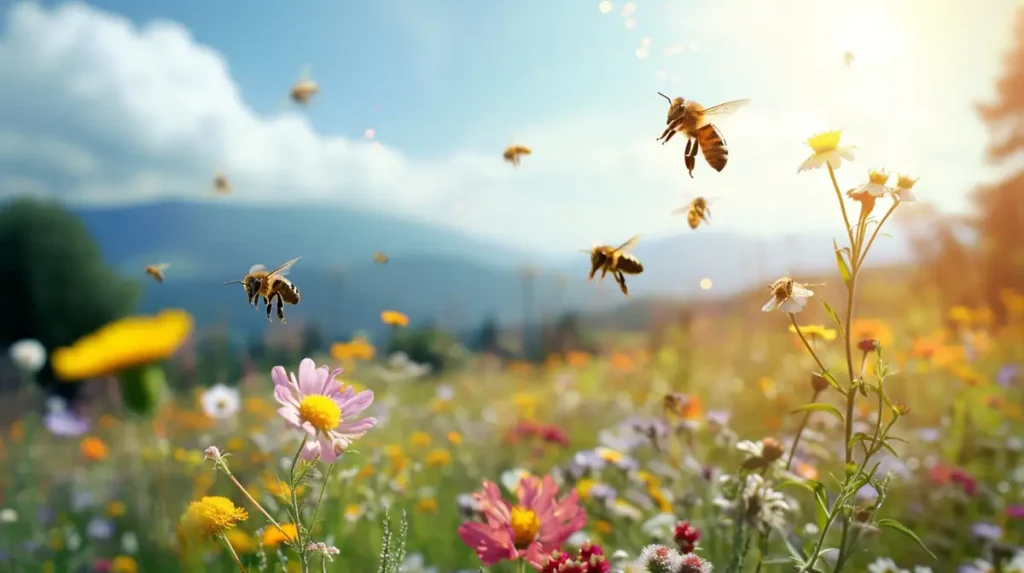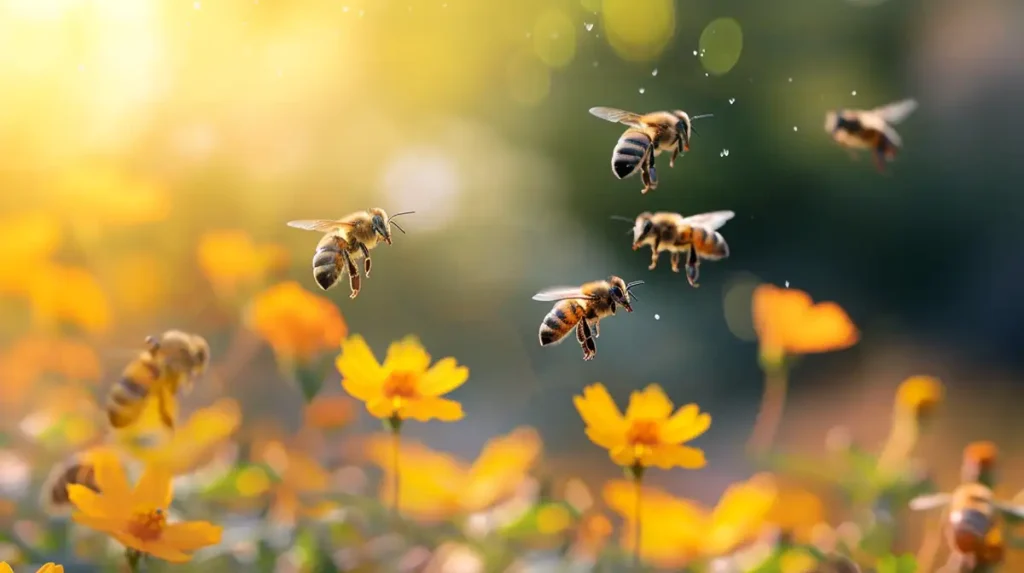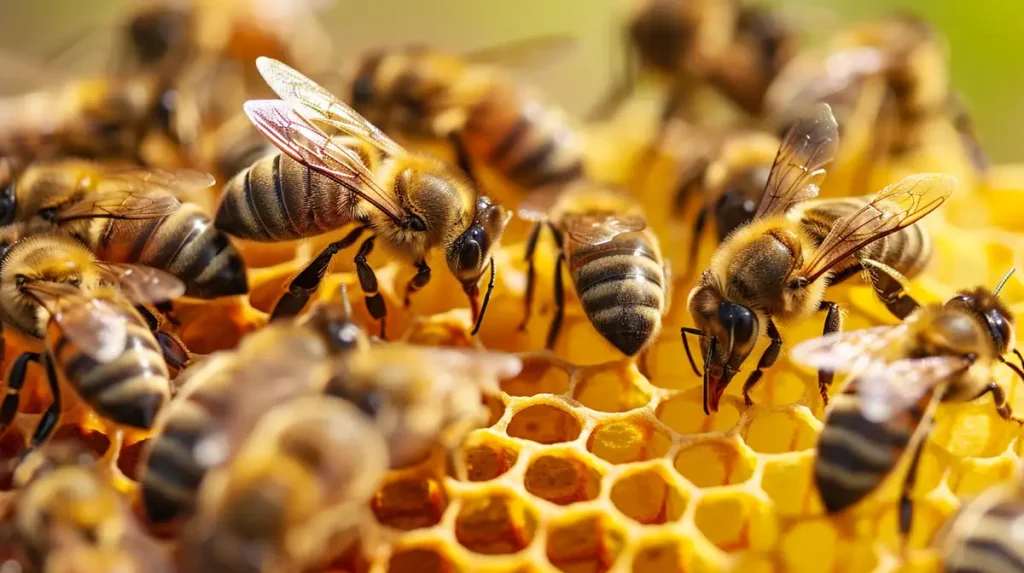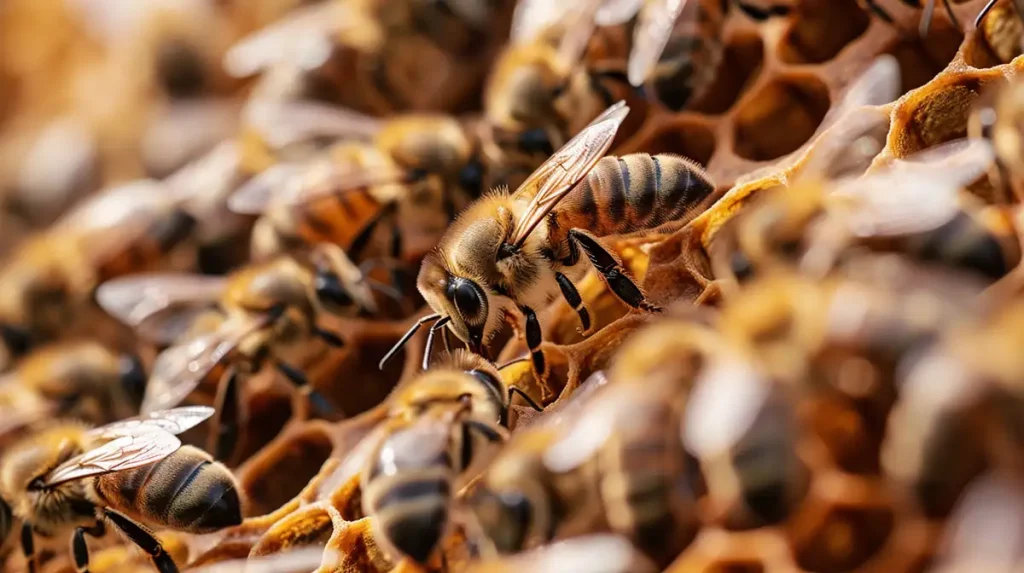Table of Contents
The number of bees in a hive can vary widely depending on factors such as species, time of year, hive health, and environmental conditions. A healthy and populous hive of the common Western honey bee typically contains between 10,000 and 60,000 bees during peak season. These include one queen bee responsible for laying eggs, a few hundred male drones whose primary role is to mate with a queen from another hive, and thousands of female worker bees that perform various tasks necessary for hive maintenance, food collection, and brood care. In winter, the hive population decreases as bees die and the queen reduces or stops laying eggs, while in spring and summer, the population increases as the queen’s egg-laying capacity reaches its peak and more food resources are available.
In the below paragraphs, we will take a more detailed look at this topic.
Key Takeaways
- Bee colonies maintain their population through reproduction, division of labor, communication, and swarming.
- The queen bee is vital in maintaining the population, laying up to 2,000 eggs per day during peak season.
- Worker bees and drones perform specific tasks to support the colony, such as foraging and mating.
- Bees rely on pheromones and physical movements to communicate, ensuring the colony functions efficiently.
- Swarming allows bees to expand their population and establish new colonies.
- Beehive population fluctuations can result from seasonal changes, pests and diseases, food availability, pesticide exposure, and swarming.
- A beehive’s size can be an indicator of its health and productivity, but other factors, such as population growth, comb and honey production, and pest and disease management, should also be considered.
Embarking on the fascinating journey of beekeeping often presents numerous questions, one of which typically pertains to the population size of a beehive. Contrary to common assumptions, which estimate only a few thousand bees, a thriving beehive can house an astounding 80,000 bees. These industrious insects coexist and labor in a meticulously orchestrated social structure, fostering the hive’s overall health and productivity.
For those unacquainted with the intricate dynamics of bee colonies, the composition of a beehive might come as a revelation. In even the most populous colonies, there exists but a single queen bee. This matriarch holds the critical responsibility of laying eggs and maintaining the colony’s population. Among her subjects one can find a modest contingent of drones, numbering in the hundreds. These male bees serve the primary purpose of mating with the queen to ensure the continuation of the colony’s lineage.
The vast majority of a beehive’s inhabitants, however, are the diligent female worker bees. These tireless foragers, builders, and caretakers are the backbone of the colony, undertaking a diverse range of tasks vital to the hive’s survival. From foraging for nectar and pollen to constructing the intricate honeycomb structure, these worker bees contribute immensely to the hive’s prosperity.

What Is The Average Number Of Bees In A Hive?
The average number of bees in a hive can vary greatly depending on factors such as the time of year, the health and strength of the colony, and the availability of food resources. In general, a healthy hive during peak season (late spring and summer) will have somewhere between 40,000 to 60,000 bees. This number includes worker bees, drones, and a single queen bee.
Breakdown of the Bee Population
- Worker Bees: These female bees make up the vast majority of the hive population, usually numbering between 30,000 to 50,000. They perform various essential tasks such as foraging for nectar and pollen, building and maintaining the hive, and taking care of the brood.
- Drones: These male bees are significantly fewer in number, typically ranging from 1,000 to 2,000. Their primary purpose is to mate with the queen bee, after which they will die.
- Queen Bee: There is usually only one queen bee in a hive. She is the mother of all other bees and is responsible for laying eggs to ensure the growth and survival of the colony.
It’s important to note that the number of bees in a hive can fluctuate throughout the year. During the winter months, the colony will enter a state of semi-hibernation, and the population may drop to around 10,000 to 20,000 bees. As spring approaches and temperatures rise, the colony will begin to expand again in preparation for the busy foraging season. Regularly monitoring your hive and ensuring it has sufficient food and space means you can help support a thriving bee population.
How Does The Population Of A Beehive Change Throughout The Year?
Beehive population dynamics are influenced by several factors including seasonality, resource availability, and the overall health of the colony. In general, a beehive’s population changes significantly throughout the year, following a cyclical pattern.
Spring
During spring, as flowers begin to bloom and pollen and nectar become more readily available, the queen bee starts laying eggs at a rapid pace. This increase in egg-laying leads to a population boom in the hive as more worker bees are born to forage for food and care for the growing brood.
Summer
As summer arrives, the hive population usually reaches its peak. The worker bees, now in their prime, forage for nectar and pollen, which they use to create honey and feed the colony. This is also when swarming may occur, where a portion of the hive’s population, including a new queen, leaves to establish a new colony elsewhere. This natural event helps ensure the propagation of honeybee populations.
Autumn
In the fall, the queen bee reduces her egg-laying activities and the colony prepares for the colder months ahead. Worker bees focus on storing honey and insulating the hive by sealing cracks and crevices with propolis, a resinous mixture collected from plants. As resources become scarcer, the hive population starts to decline and the colony begins to focus on conserving energy.
Winter
During winter, the beehive population is at its lowest. The queen stops laying eggs and the remaining worker bees cluster around her, generating warmth to keep the colony alive. The bees rely on their honey stores for nourishment and focus on surviving the cold months. Once spring returns, the cycle begins anew and the queen resumes laying eggs to rebuild the colony’s population.
- Carter, Anthony (Author)
- English (Publication Language)
- 194 Pages - 02/28/2024 (Publication Date) - Independently published (Publisher)
What Factors Affect The Size Of A Bee Colony
Several factors can influence the size of a bee colony including the availability of resources, the queen’s fertility, the presence of diseases or pests, and environmental conditions.
Resource Availability
The availability of nectar, pollen, and water in the surrounding environment plays a significant role in the size of a bee colony. Abundant resources allow the colony to grow whereas limited resources can lead to a smaller colony or even the collapse of the colony.
Queen Fertility
The queen bee is responsible for laying eggs and producing new bees. A healthy, fertile queen can lay up to 2,000 eggs per day, leading to a thriving colony. If the queen is not fertile or is not laying eggs at an optimal rate, the colony may not grow as desired.
Disease and Pests
Diseases, such as American Foulbrood or Nosema, as well as pests like the Varroa mite, can negatively impact the health and size of a colony. These ailments can weaken or kill the bees, leading to a decrease in colony size. Regular hive inspections and proper treatment can help control these issues.
Environmental Conditions
Environmental factors, such as temperature, humidity, and weather patterns can also impact the size of a bee colony. Bees thrive in moderate temperatures with adequate humidity, so extreme temperatures or weather events can hinder colony growth. Similarly, a lack of suitable nesting sites or disturbances to the bees’ habitat can affect the colony size.
How Do Beekeepers Determine The Population Of A Hive?
Beekeepers often need to estimate the population of a hive to monitor its health, productivity, and overall well-being. To determine the population of a hive, beekeepers typically rely on a combination of visual inspection and indirect methods.
Visual Inspection
A visual inspection involves carefully opening the hive and examining the frames, which hold the honeycomb. Beekeepers look for the presence of capped brood (sealed cells containing developing larvae) as well as adult bees. A frame full of capped brood generally contains about 2,000 to 3,000 bees. By counting the number of frames covered with bees, and multiplying that by an estimated number of bees per frame (usually around 1,000 to 1,500), they can get a rough estimate of the total population.
Indirect Methods
In addition to visual inspection, beekeepers can use indirect methods like weighing the hive or tracking foraging activity. A heavier hive often indicates a larger bee population as more bees require more food stores. Similarly, observing the number of bees entering and leaving the hive during peak foraging hours can provide an idea of the hive’s population. A busier entrance typically signifies a higher number of bees.
By combining these methods, beekeepers can closely monitor the population of their hives and make informed decisions about the management and care required for the health and productivity of their colonies.
How Many Bees Do I Need to Start a Beehive?
When getting started on your beekeeping journey, you are likely to be able to buy three pounds of bees from a commercial seller, which will include a fertile queen. Although it is impossible to say exactly how many bees are in three pounds of weight, it is estimated that it will contain approximately 10,000 insects.
Once you have set up your hive and added the bees, they will get to work. In general, it takes between three and five months for the colony to get strong and become established. It is best to leave the bees alone during this time and not to take any of the honey they have produced. They will need this to feed themselves during the first winter.

How Does A Queen Bee Influence Hive Population?
The queen bee plays a vital role in maintaining the population of a honeybee hive. As the mother to all the bees in the colony, she’s responsible for laying eggs and ensuring the survival of her offspring. The queen can lay up to 1,500-2,000 eggs per day during peak season, which significantly affects the hive’s population.
Mating and Egg Laying
The queen’s ability to influence the hive’s population starts with her mating process. Within the first few weeks of her life, she embarks on a mating flight where she mates with multiple drones in the air. These drones provide her with the sperm she’ll use for the rest of her life to fertilize eggs. After successful mating, the queen lays fertilized eggs that develop into female worker bees or unfertilized eggs that become male drones. The workers make up the majority of the hive’s population and perform essential tasks like foraging and caring for the brood, while drones focus on mating with other queens.
Pheromones and Communication
The queen bee’s influence on hive population goes beyond egg-laying; she also communicates with her colony through pheromones. These chemical signals help regulate the hive’s activities, including brood rearing, foraging, and defense. One crucial pheromone called “queen mandibular pheromone” (QMP) suppresses the worker bees’ ability to lay eggs, ensuring that the queen is the sole egg-layer. This pheromone also helps maintain a sense of unity within the colony and promotes the workers’ productivity.
Swarming and Supersedure
When a hive becomes overcrowded or resources are scarce, the colony may initiate a process called swarming wherein a portion of the bees, along with the old queen leave the hive to establish a new colony. Before departing, the worker bees create new queen cells to rear potential successor queens. Once a new queen emerges she takes over the hive, ensuring the original colony’s population continues to thrive.
In some cases, a colony may replace an underperforming or aging queen through a process called supersedure. The workers create supersedure cells, and a new queen emerges to challenge the old one. If the new queen successfully eliminates the old queen, she takes over the colony’s reproductive duties, affecting the hive’s population dynamics.
Can Bees Survive Without a Queen?
The queen’s job within the hive is to lay eggs. It is she who decides whether an egg will be male or female by choosing whether to fertilize them or not. I already mentioned that fertilized eggs hatch as female worker bees whereas unfertilized eggs will be male drones.
The queen is also responsible for the regulation of behavior and harmony in the colony. She releases pheromones that keep the rest of the bees calm and working as they should. Without her, the colony would descend into chaos and after a few weeks the remaining bees would die off.
When a queen dies, she will be replaced either by the beekeeper or the bees themselves. Worker bees will identify possible future queens in the larvae and will begin to raise them as such. Once these virgin queens hatch, conflict ensues between them until there is only one queen remaining. She will then begin mating with the drones over a period of a couple of days. She will store the sperm and will draw on this when laying eggs for the rest of her life. Most queens can continue laying with sperm collected from their mating flight for around three years. When she runs out of sperm, she will be replaced by the bees or the beekeeper.
How Does A Bee Colony Maintain Its Population?
A bee colony is an intricate, self-regulating society that maintains its population through a combination of reproduction, division of labor, and communication. The queen bee plays a vital role in population management.
Division of Labor
The bee colony is made up of three distinct types of bees: the queen, worker bees, and drones. Each has a specific role to play in maintaining the colony’s population. Worker bees, which are all female, tend to various tasks such as foraging for nectar and pollen, nursing and feeding the larvae, and protecting the hive. Drones, or male bees, have one primary purpose: to mate with the queen and fertilize her eggs.
Bee Communication
Bees use complex communication methods to coordinate their activities and ensure the colony functions smoothly. They rely on a combination of pheromones, or chemical signals, and physical movements like the waggle dance to convey messages about the location of food sources, the need for defense and other essential tasks. These communication methods help to maintain the colony’s population by keeping it well-fed, healthy, and safe from predators.
Swarming and Colony Division
When a colony becomes overcrowded or resources become scarce, the bees swarm. This is where the old queen and about half of the worker bees leave the hive to find a new location, while a newly-hatched queen stays behind to take over the original colony. Swarming serves as a way for bees to expand their population and establish new colonies, ensuring the survival of their species.
What Causes Beehive Population Fluctuations?
Beehive population fluctuations are a normal part of a colony’s life cycle, but various factors can cause more significant changes in bee numbers:
Seasonal Changes
Honeybee populations naturally rise and fall with the seasons. In the spring and summer, the colony expands as new bees are born and foraging activity increases. Conversely, during the fall and winter, the colony population declines as worker bees die off and the queen bee reduces her egg-laying.
Pests and Diseases
Various pests and diseases can also impact beehive populations. For instance, Varroa mites weaken bees by feeding on their hemolymph (bee blood) and spreading viruses. Other issues, such as American Foulbrood and Nosema, can cause severe damage to a colony, leading to population decline or even colony collapse.
Food Availability
Bee populations are highly dependent on the availability of food sources. A lack of nectar and pollen can lead to malnutrition, hindering colony growth and causing a decline in population. This can happen due to environmental factors such as drought or habitat loss, or because of a lack of diverse flowering plants within the bees’ foraging range.
Pesticide Exposure
Pesticides, especially those containing neonicotinoids, can have detrimental effects on honeybees. Exposure can lead to disorientation, reduced foraging success, weakened immune systems, and eventually, population decline.
Swarming
We have discussed swarming in the above paragraphs, so no need for detail here.
Understanding these factors can help beekeepers monitor and maintain healthy beehive populations. By providing adequate food sources, managing pests and diseases, and reducing exposure to harmful chemicals, beekeepers can support their colonies through these natural fluctuations.

Can A Beehive’s Size Indicate Its Health And Productivity?
Yes, a beehive’s size can be an indicator of its health and productivity. When a colony of bees is thriving the hive size generally expands, reflecting a healthy and productive environment. Nevertheless, it’s important to note that other factors should be considered as well.
Population Growth
A healthy beehive will have a steadily increasing population. The queen bee is responsible for laying eggs, and a robust colony should have a consistent and strong egg-laying pattern. If you notice a decline in the population or a lack of new brood, this could signal health or productivity issues within the hive.
Comb and Honey Production
Another indication of a healthy and productive beehive is the rate of comb and honey production. Bees need to build comb to store honey, pollen, and raise new brood. If the colony is creating new comb at a steady rate and filling it with honey and pollen, this is a good sign of productivity.
Pest and Disease Management
A large hive can be a target for pests and diseases, which can affect its overall health and productivity. A healthy hive is capable of defending itself against pests like varroa mites and wax moths, as well as managing diseases like American foulbrood and chalkbrood. Regular inspections can help you identify and address these issues early on.
How Many Bees in a Hive – Conclusion
An average, a beehive contains around thirty thousand bees, but this number goes up or down depending on a range of circumstances. For example, a new hive will have around 10,000 bees until the queen begins laying eggs and the colony grows. During the winter months, the number of bees in the hives drops as all male drones are either dead or ousted from the hive. The remaining bees work together to keep the temperature at optimum levels for survival until the queen can begin laying again in the springtime.
If a queen dies, she must be replaced as soon as possible or the number of bees in the hive will drop dramatically. If she is not replaced, the other bees will soon die off.
Looking to up your beekeeping game? Check out our latest product recommendations so you can take things to the next level!
Introducing The Top 12 Best Beekeeping Veils For 2024
Introducing The Top 20 Best Beekeeping Gloves For 2024
Introducing The Absolute Best Beekeeping Suits For 2024
The 15 Top Beekeeping Books for 2024
The Top 11 Honey Extractors for 2024
The Top 12 Mason Bee Houses for 2024
Beekeeping Disclaimer:
Beekeeping, like any agricultural activity, involves inherent risks. It is important to understand these risks and take appropriate measures to mitigate them.
Potential risks associated with beekeeping include:
- Bee stings: Honeybees are generally not aggressive but can become defensive if they feel threatened or their hive is disturbed. Bee stings can cause allergic reactions or even anaphylaxis in some individuals, which can be life-threatening. It is important to wear protective clothing and follow best practices when handling bees to minimize the risk of stings.
- Diseases and pests: Bees can be vulnerable to various diseases and pests, including mites, viruses, and bacterial infections. These can have significant impacts on bee colonies, leading to reduced honey production or even colony collapse. It is important to monitor hives regularly and take appropriate measures to prevent and treat diseases and pests.
- Weather conditions: Extreme weather conditions, such as drought or cold temperatures, can affect the health and productivity of bee colonies. It is important to ensure that hives are appropriately sheltered and provided with adequate food and water.
- Environmental hazards: Bees can be affected by environmental hazards such as pesticide exposure, pollution, and habitat loss. It is important to be aware of these hazards and take appropriate measures to protect bee colonies and promote healthy environments for bees.
- Legal requirements: Beekeeping may be subject to local, state, or national regulations, such as registration or inspection requirements. It is important to be aware of these requirements and comply with them.
While beekeeping can be a rewarding and enjoyable activity, it is important to be aware of the potential risks and take appropriate measures to mitigate them. By following best practices and staying informed about the latest developments in beekeeping, beekeepers can help ensure the health and productivity of their hives and contribute to the well-being of bee populations worldwide.
Last update on 2024-04-25 / Affiliate links / Images from Amazon Product Advertising API


